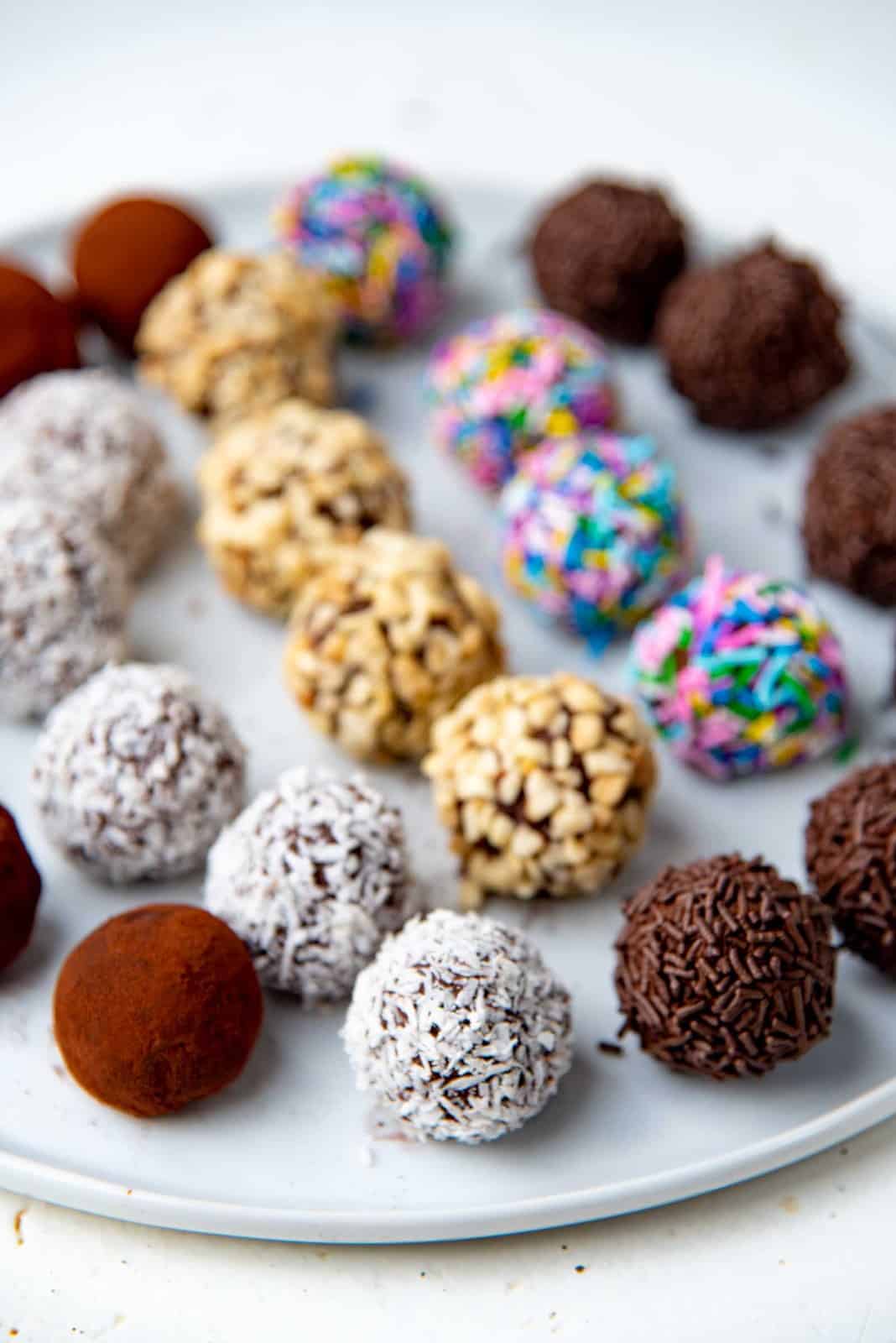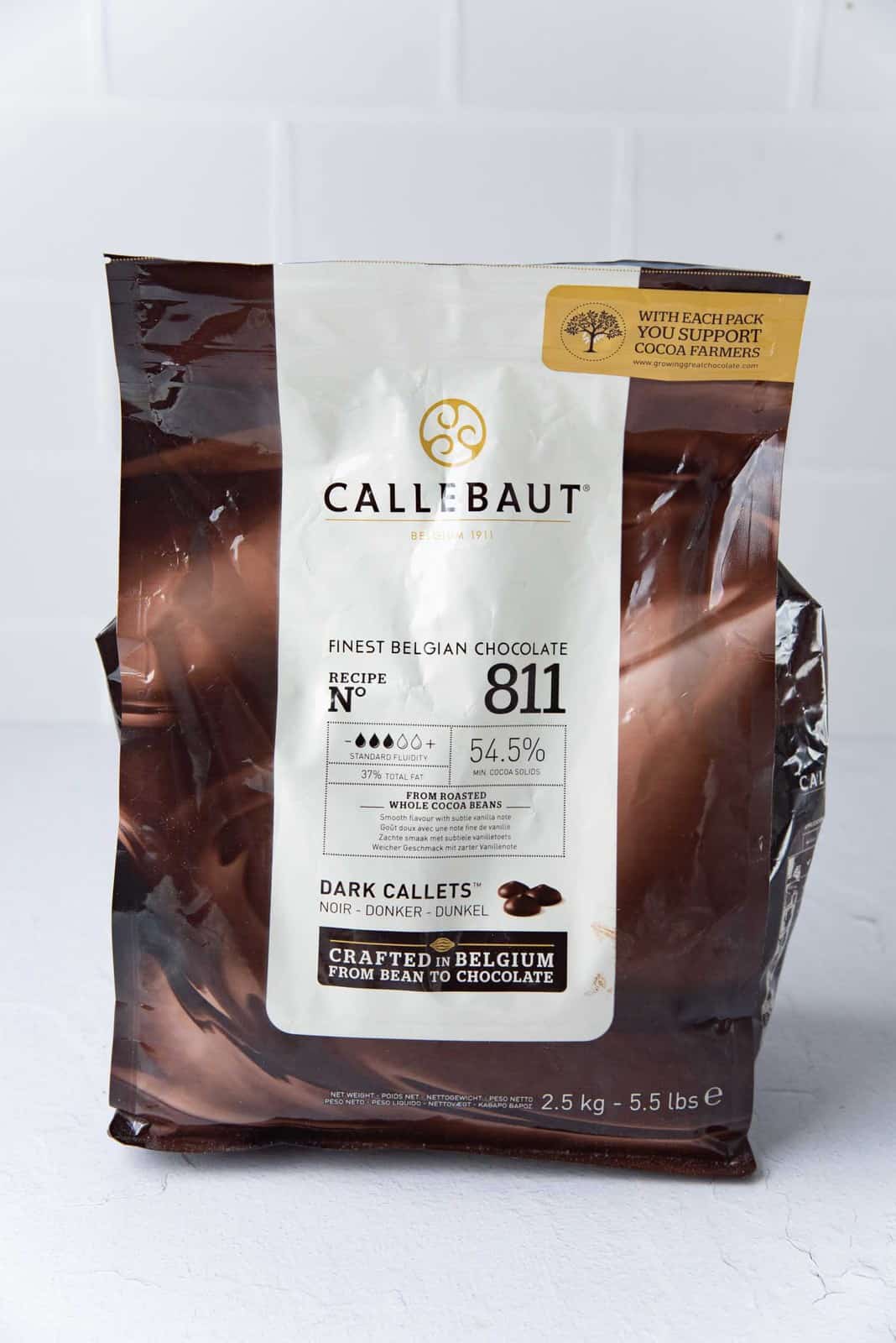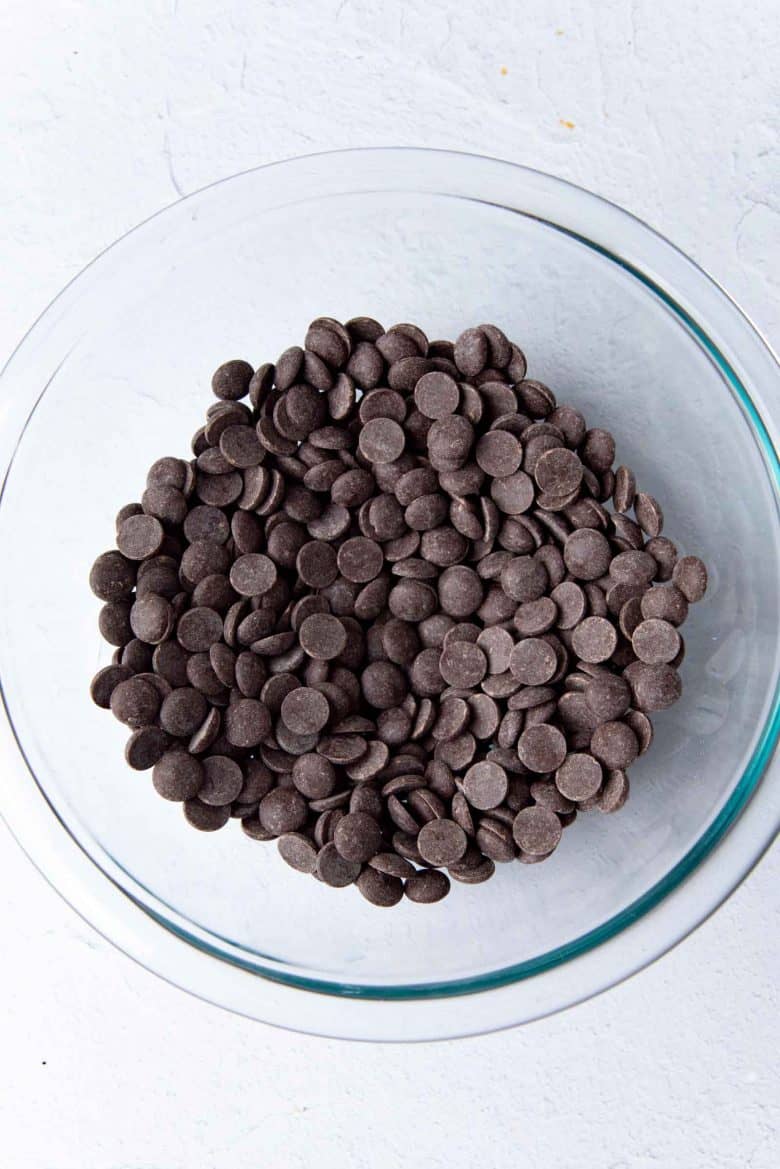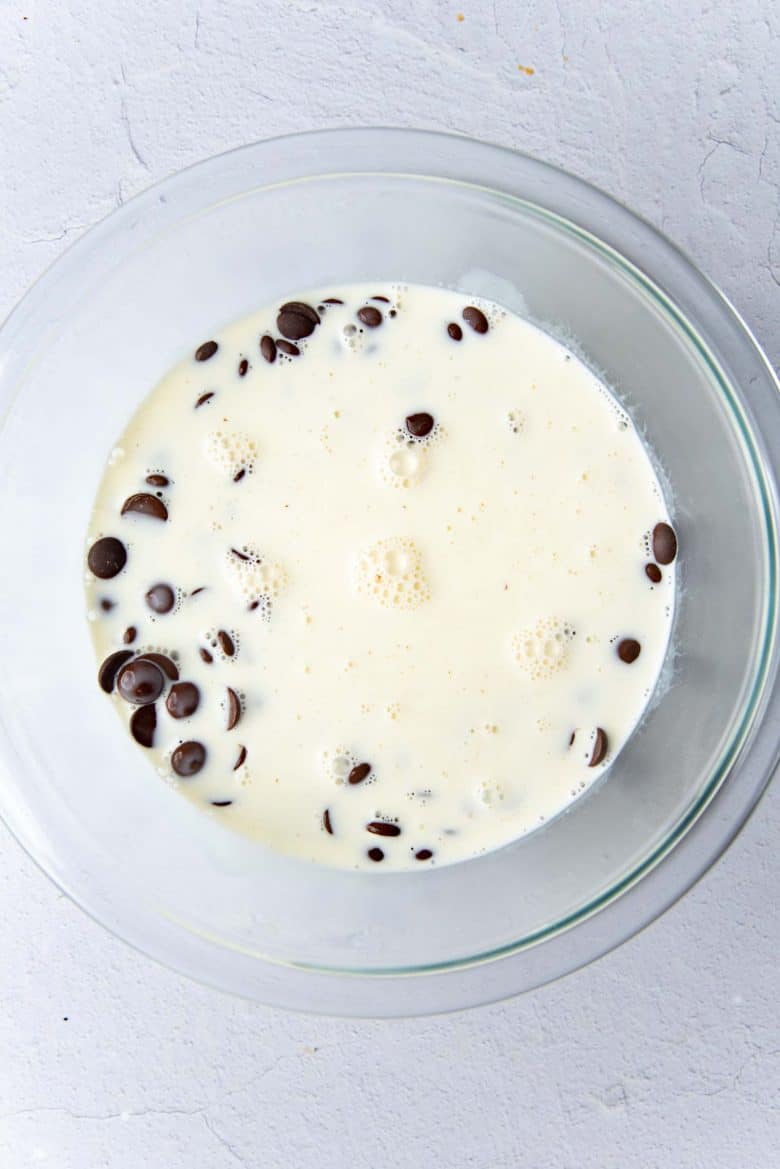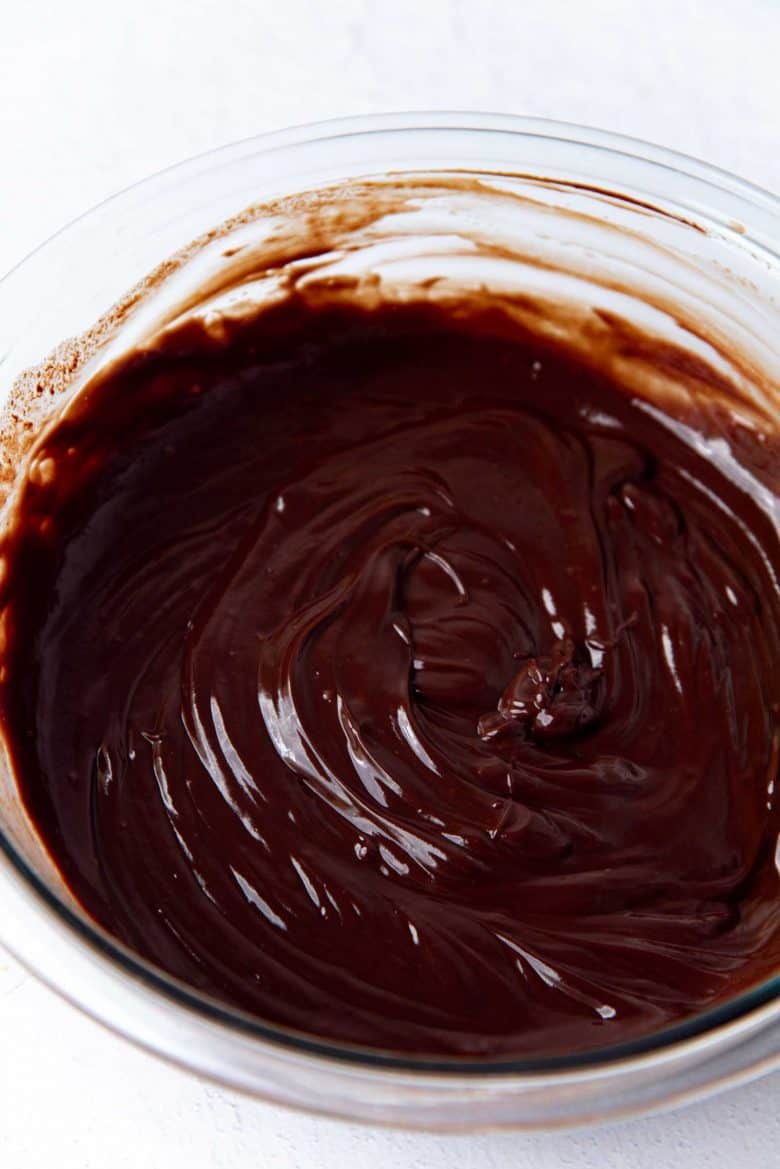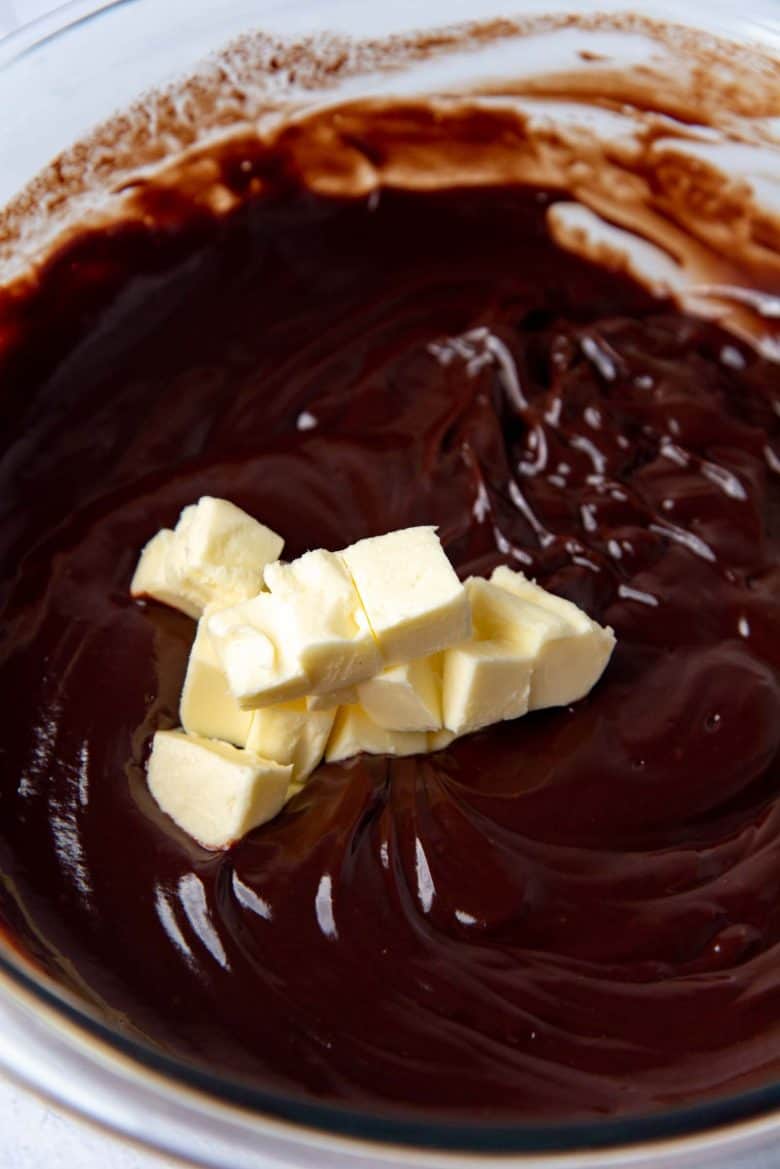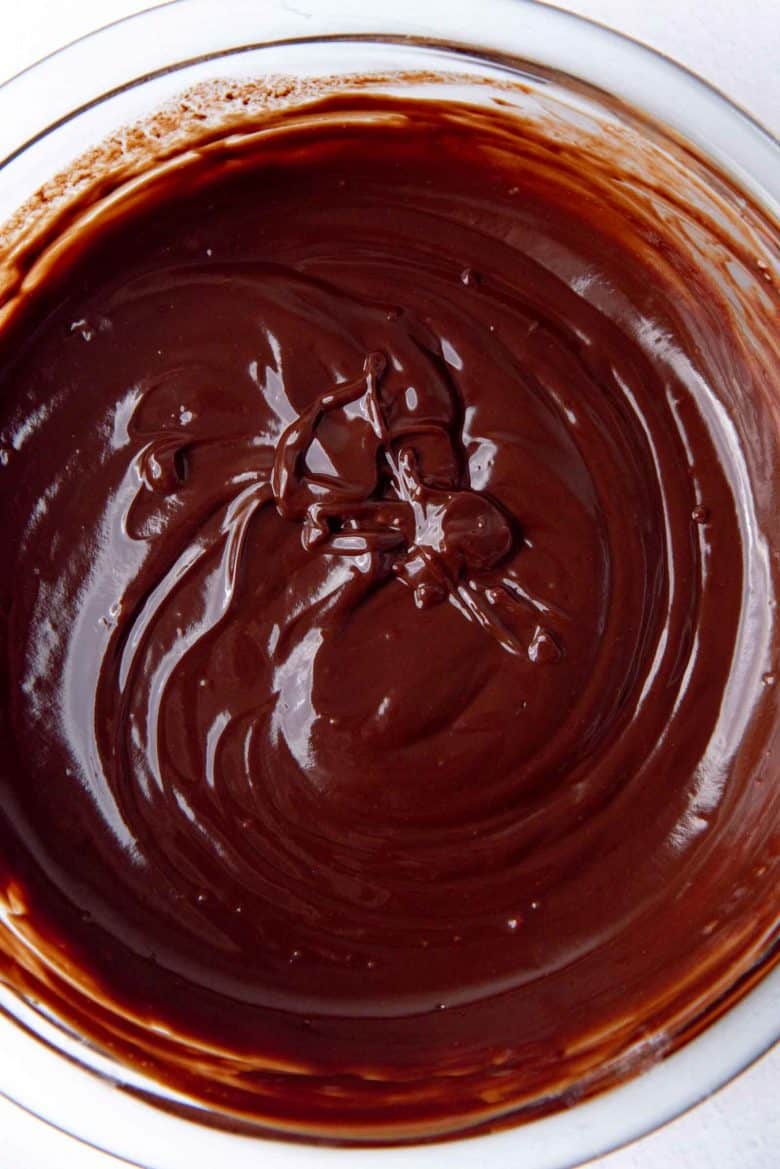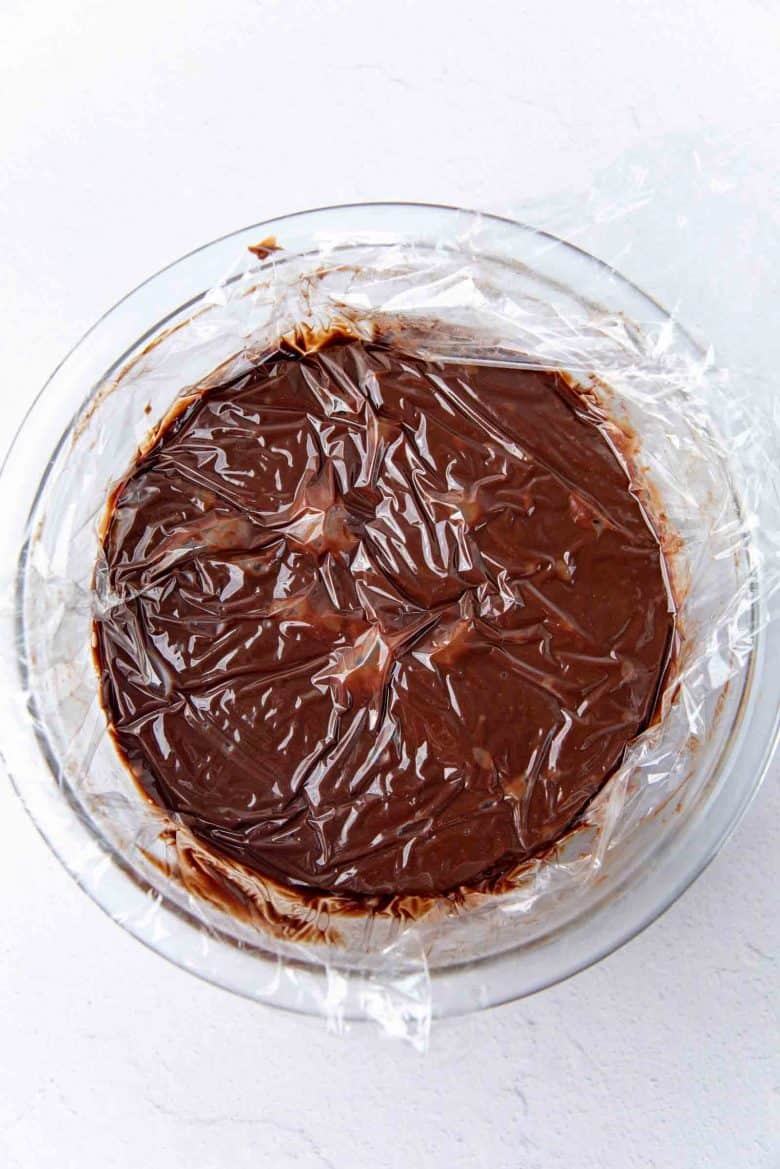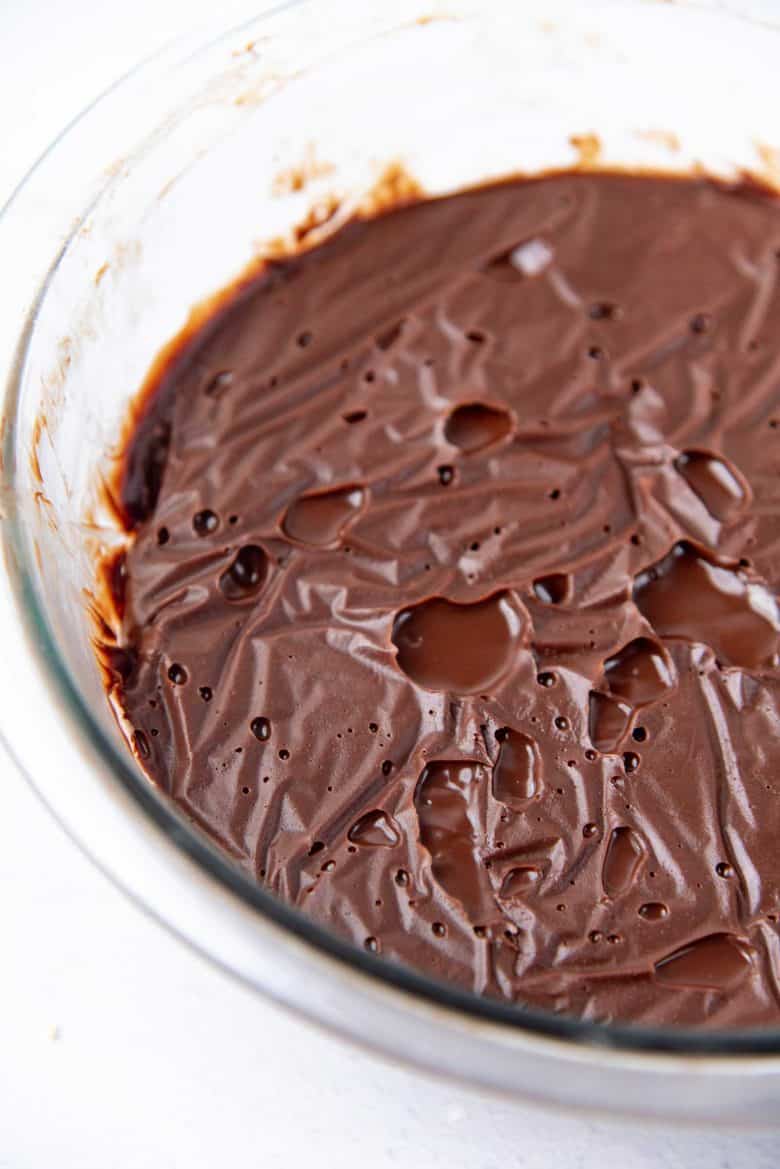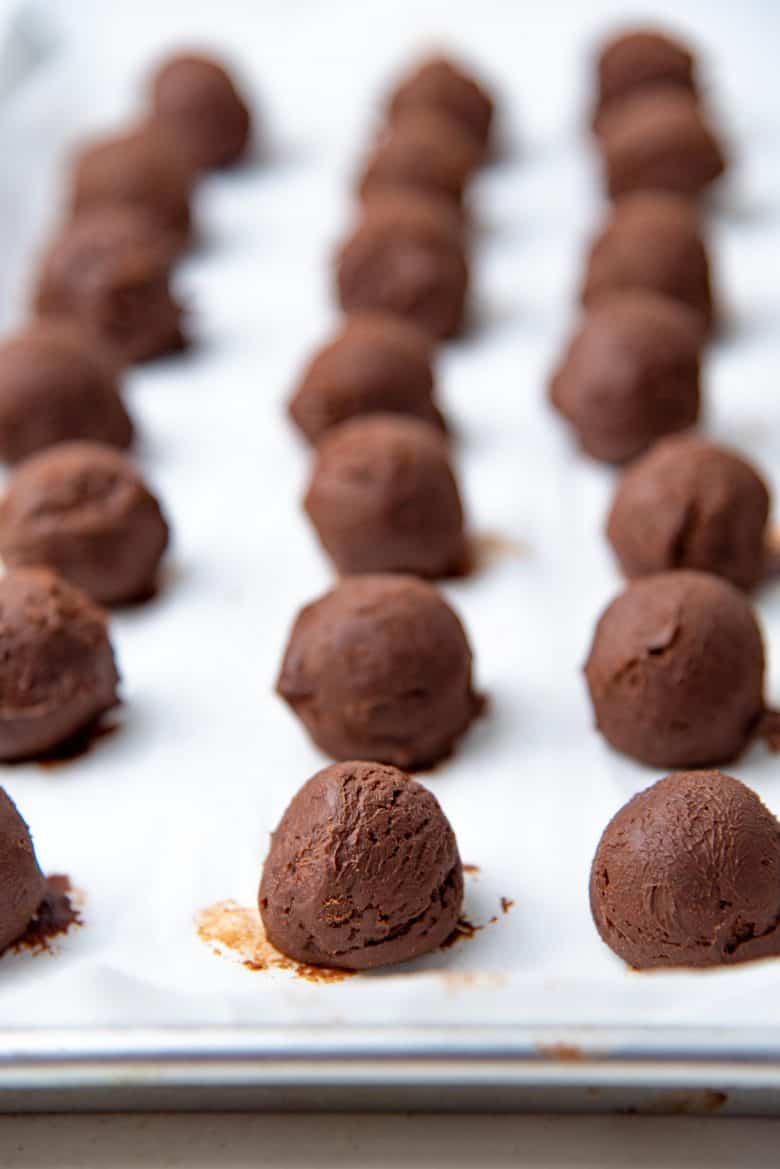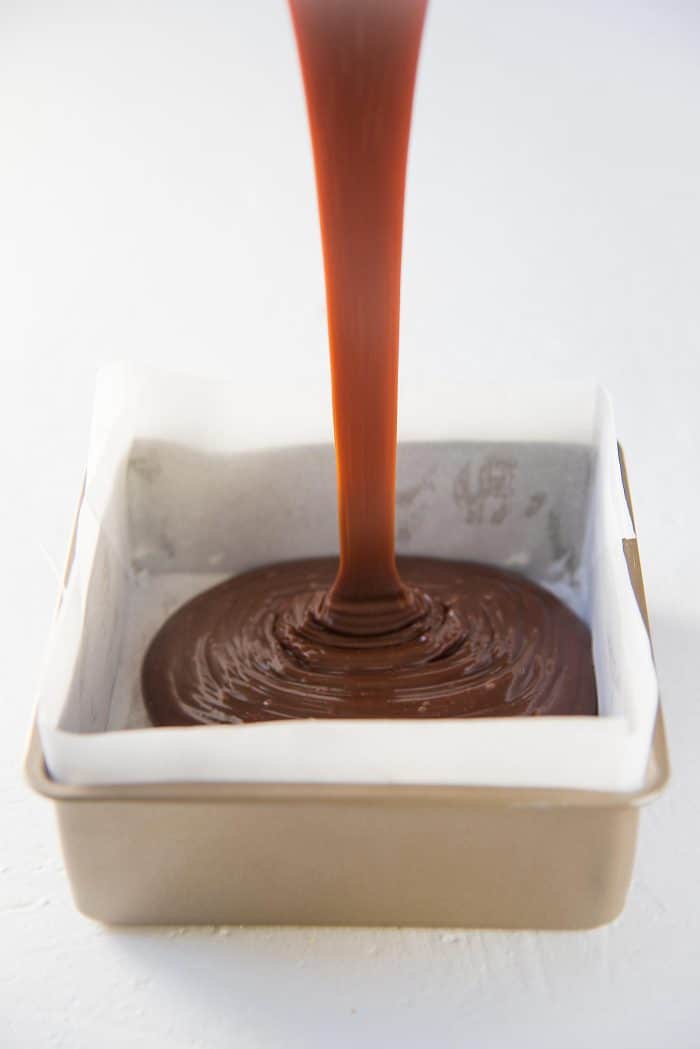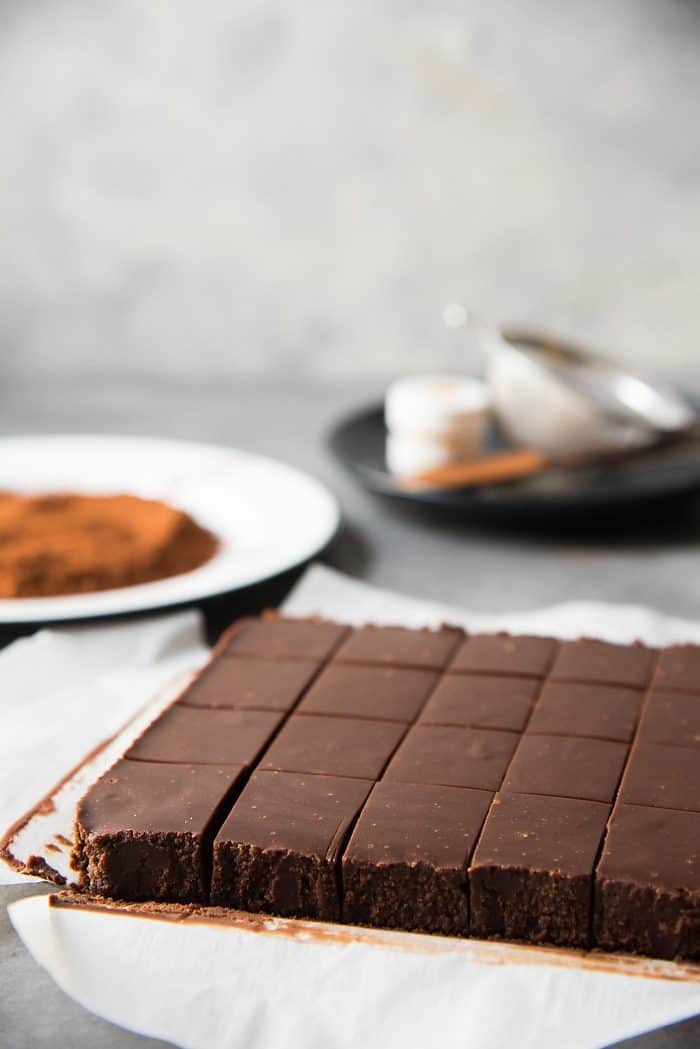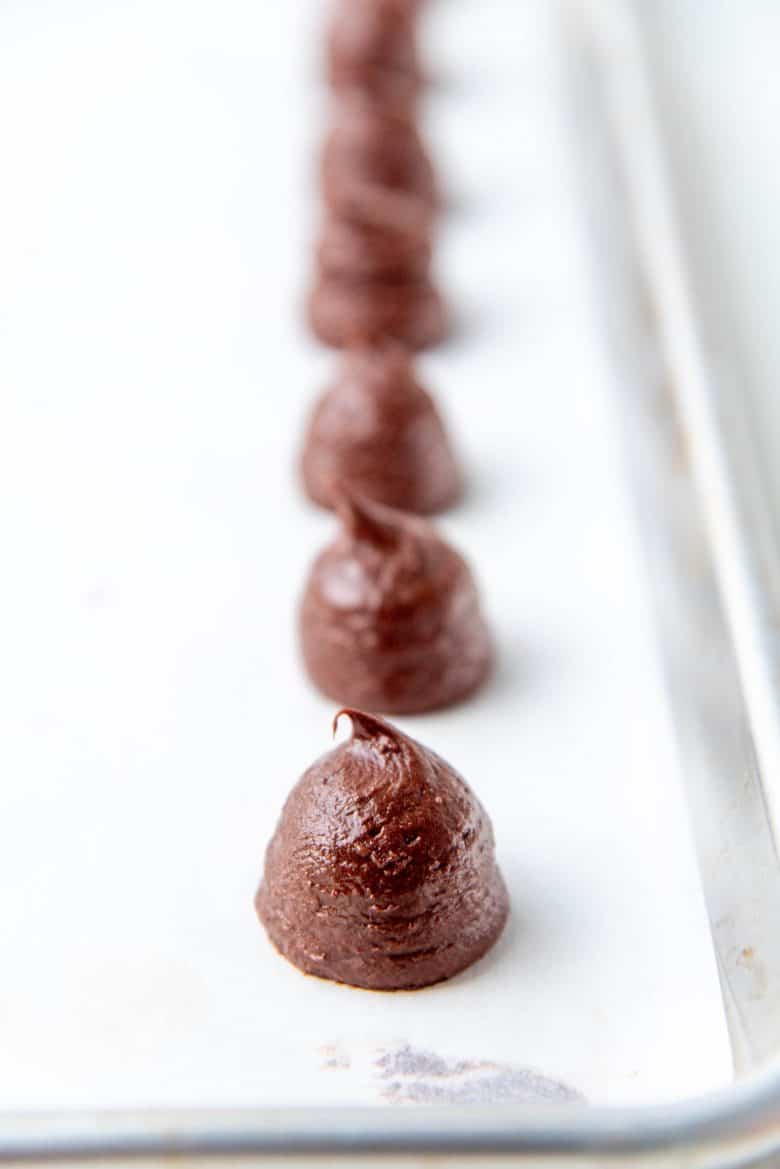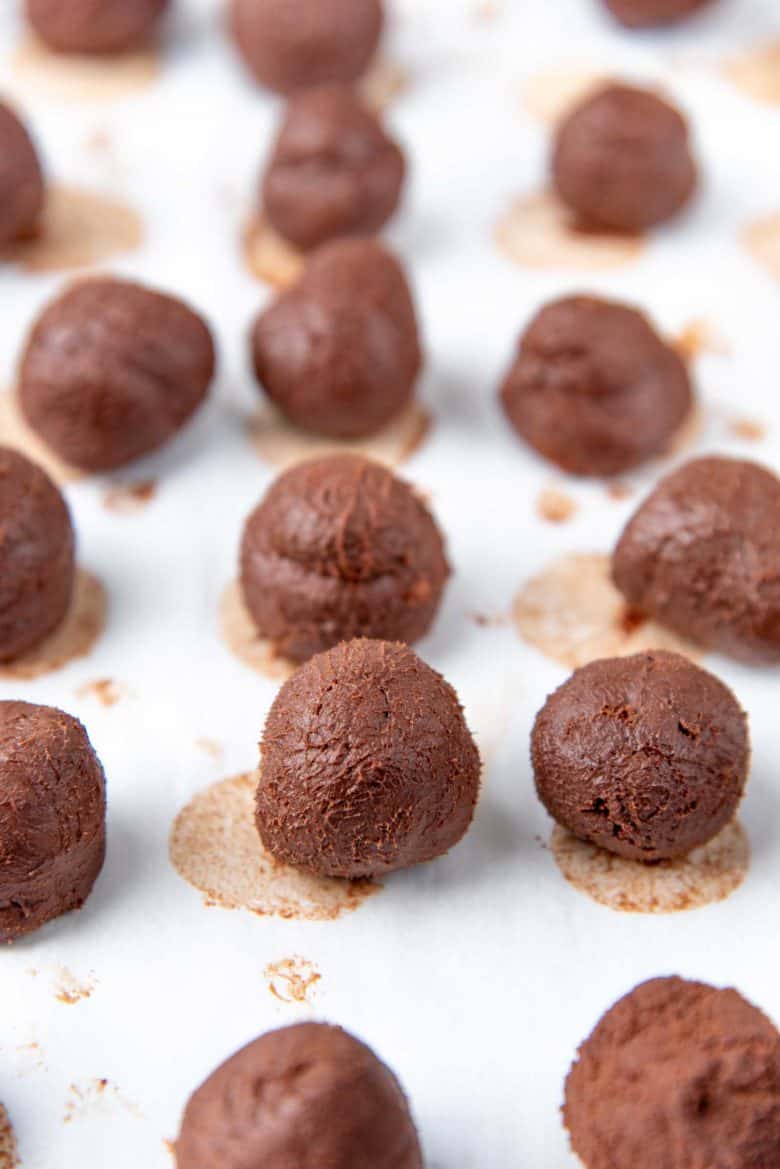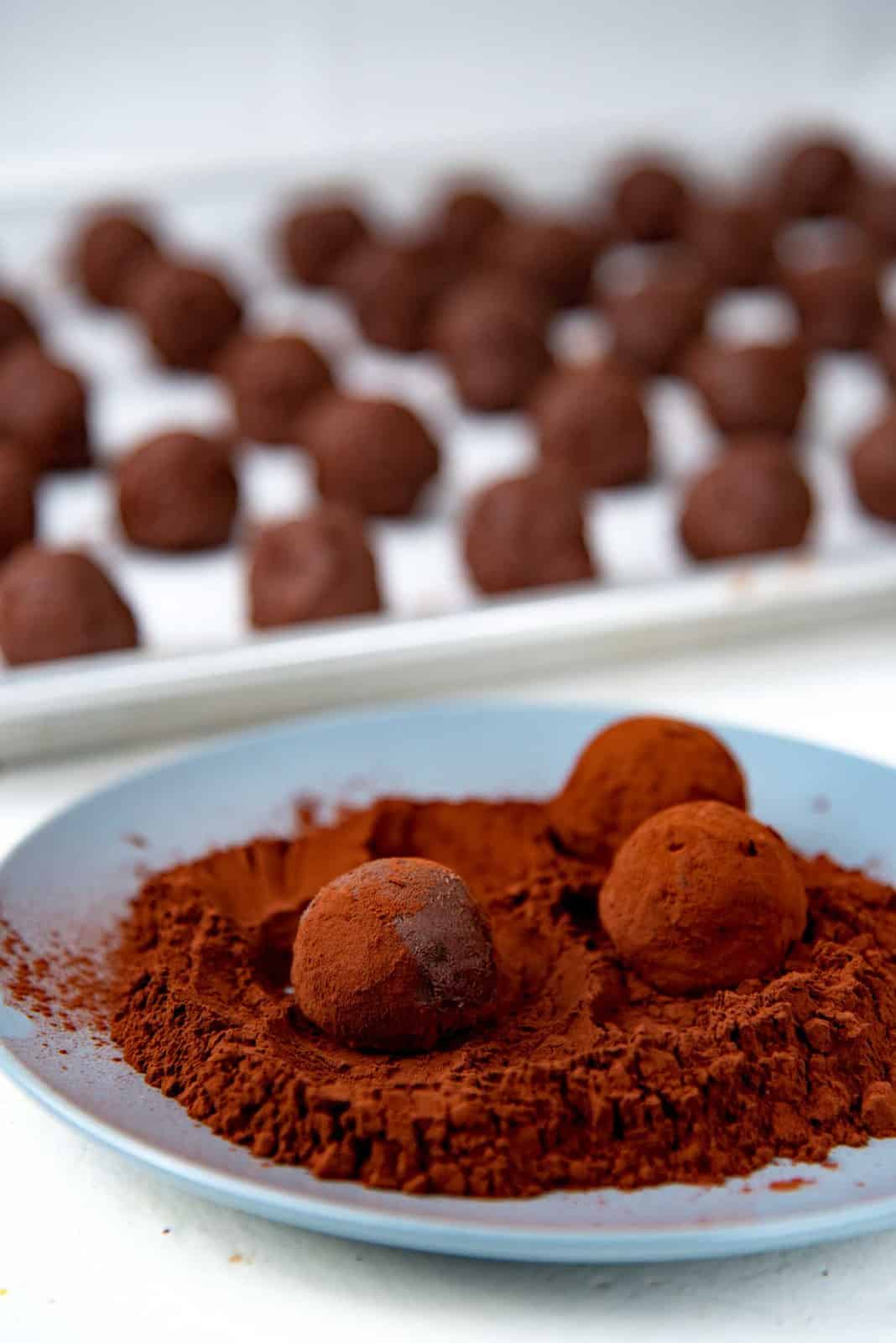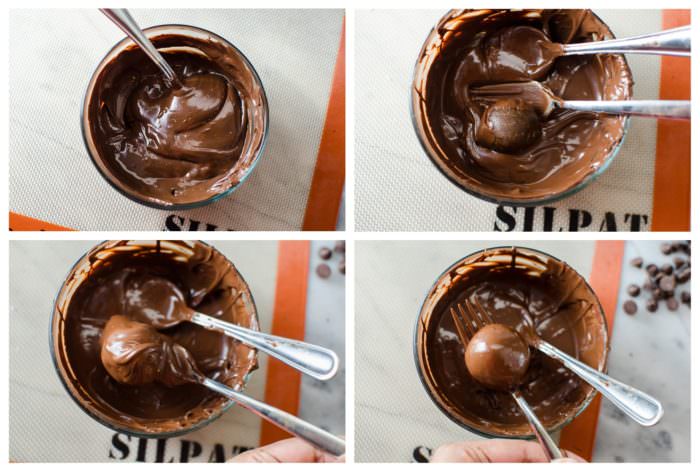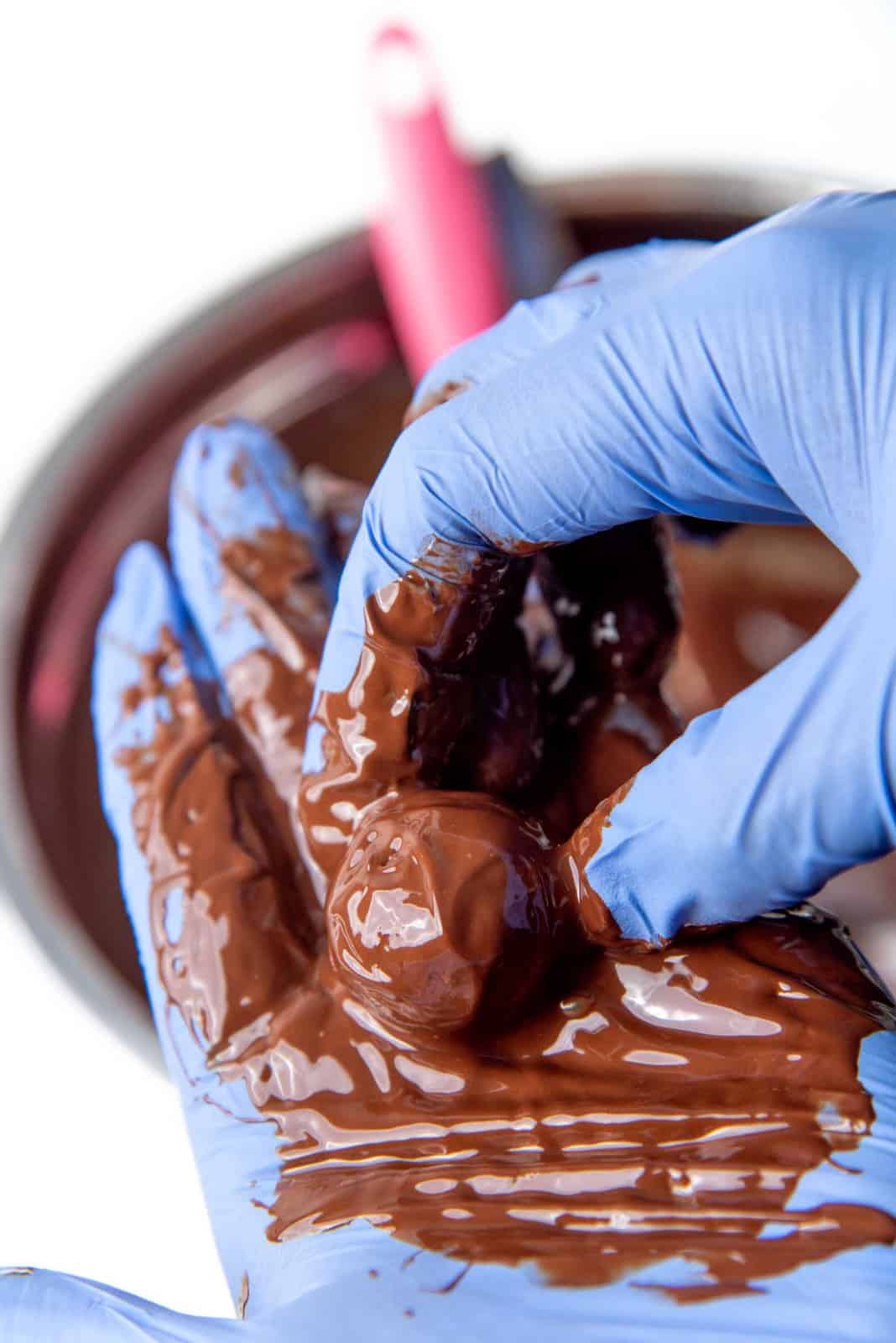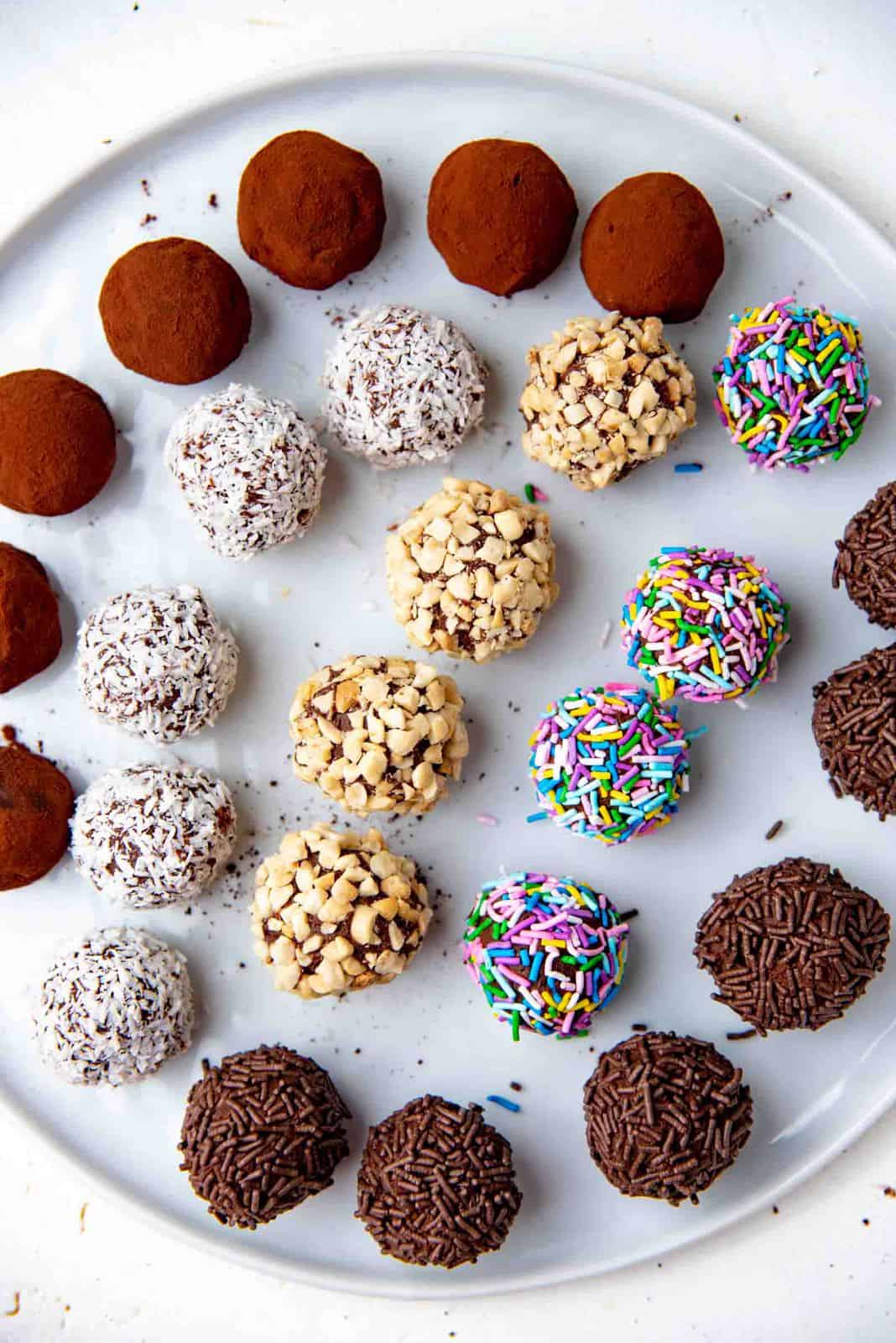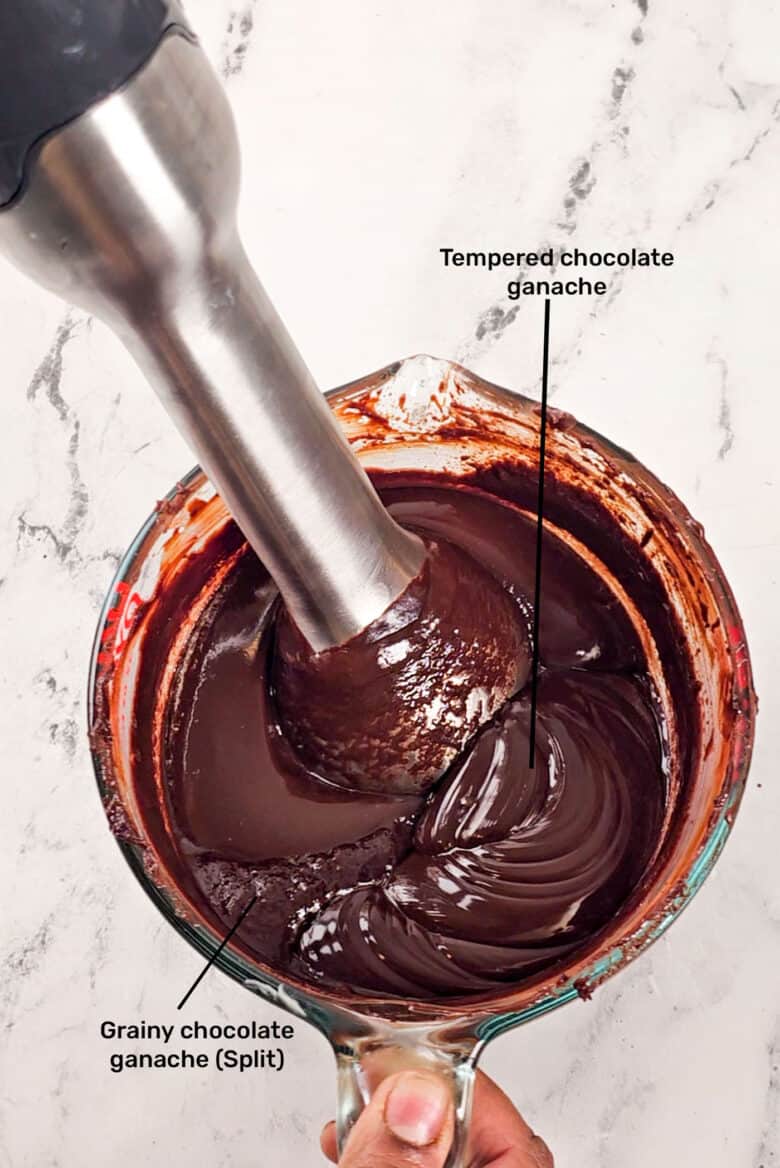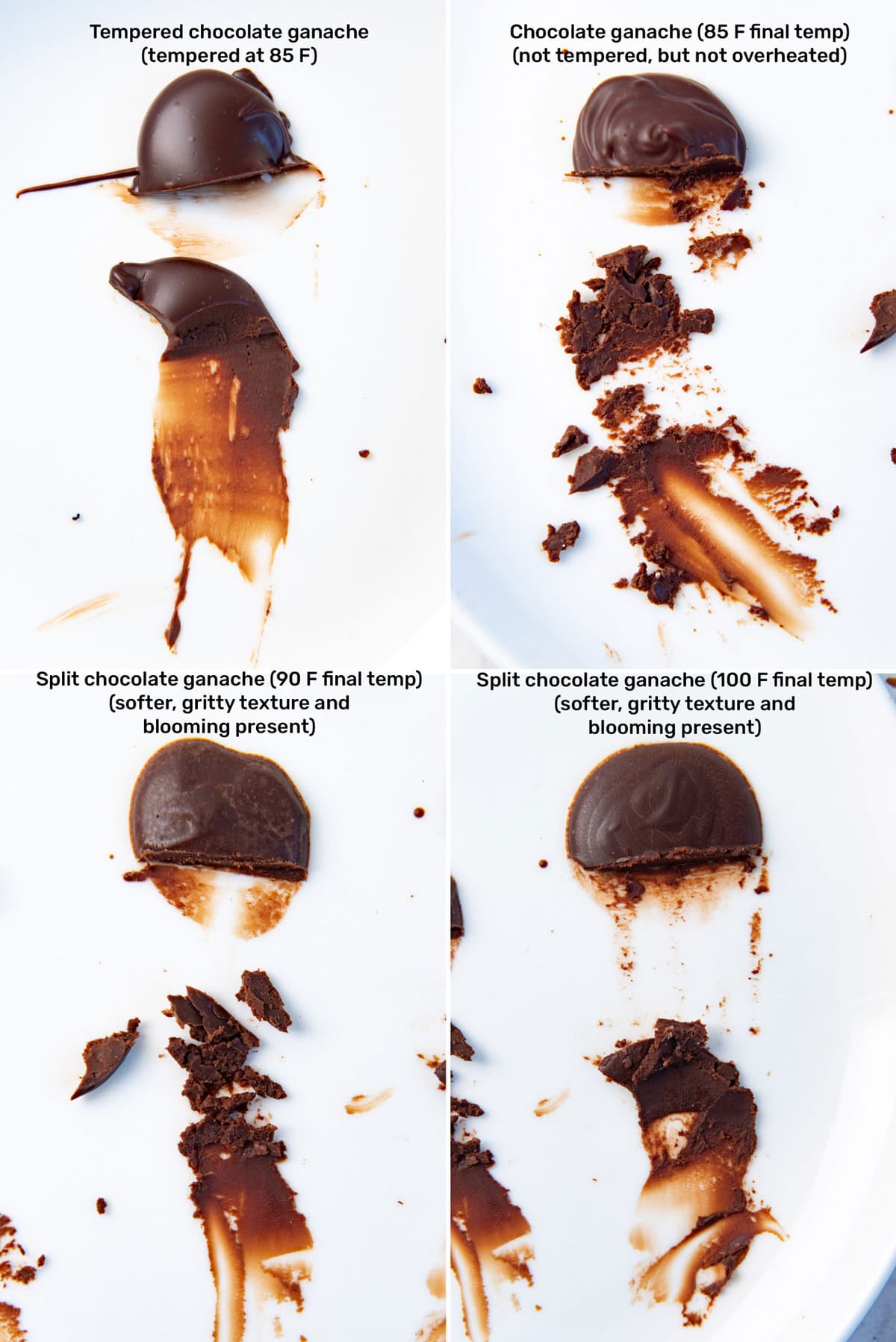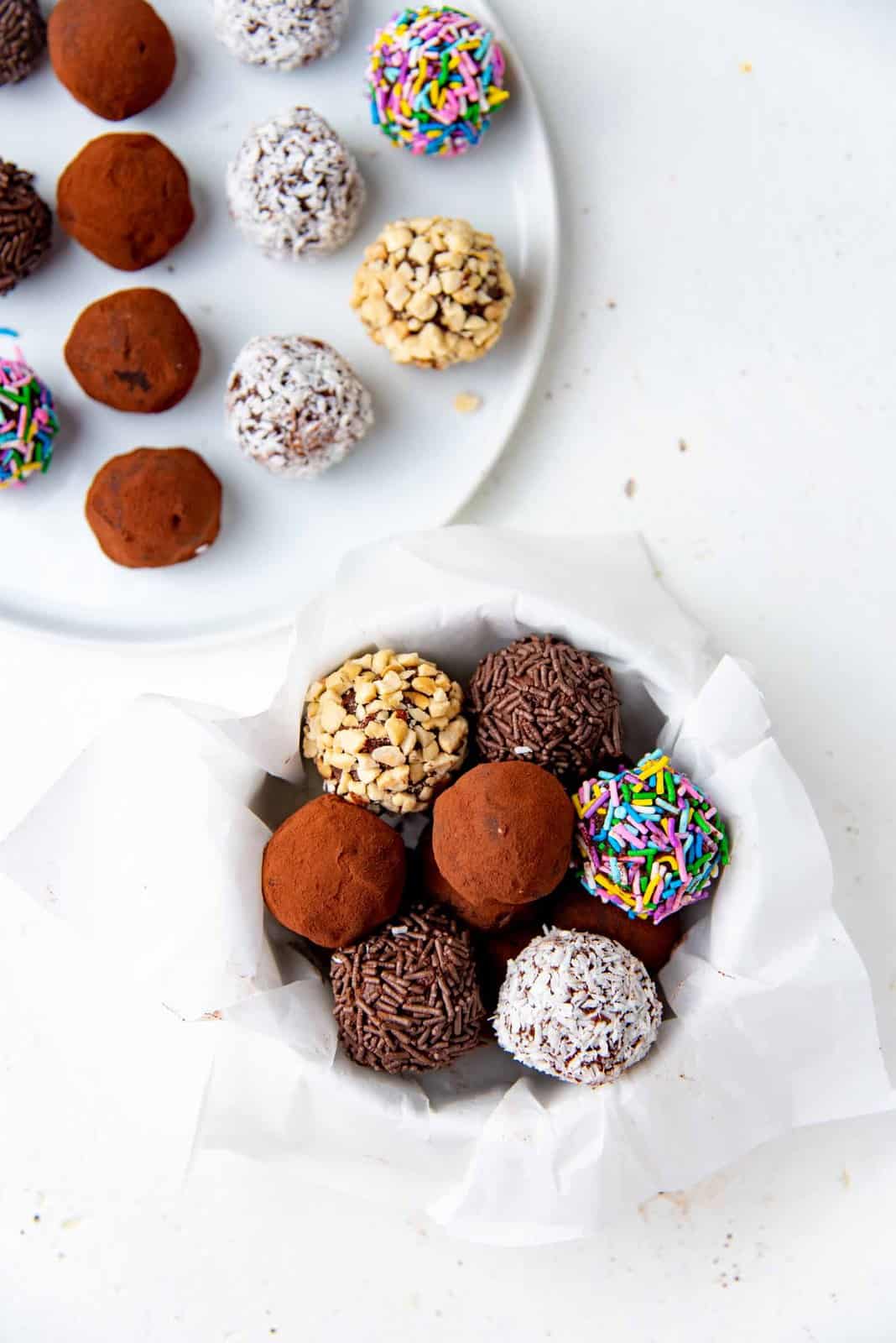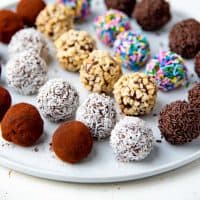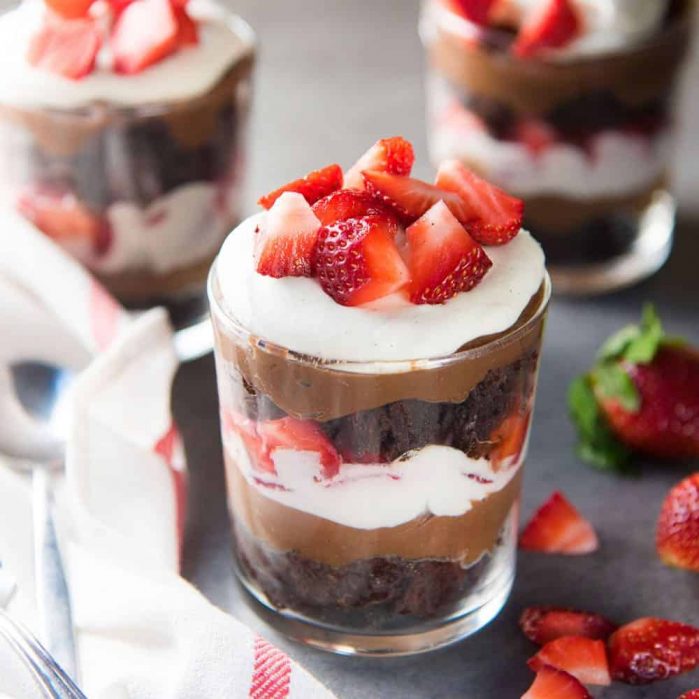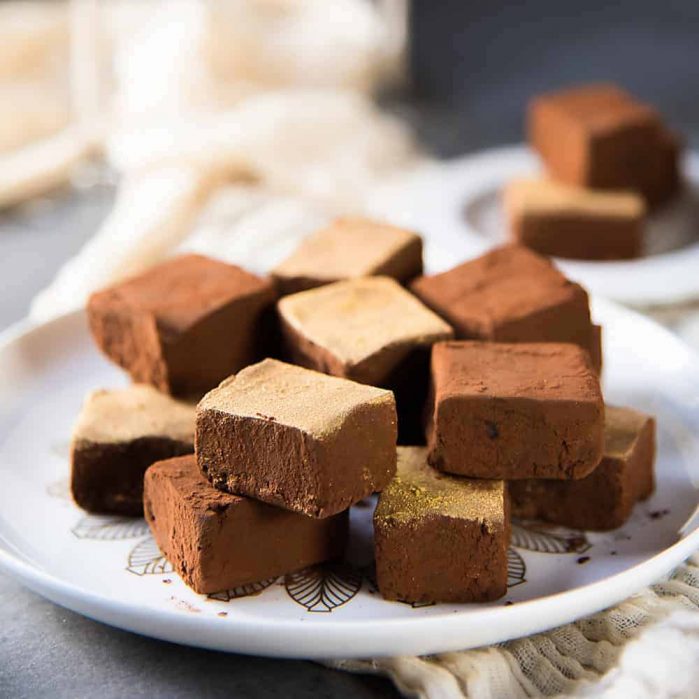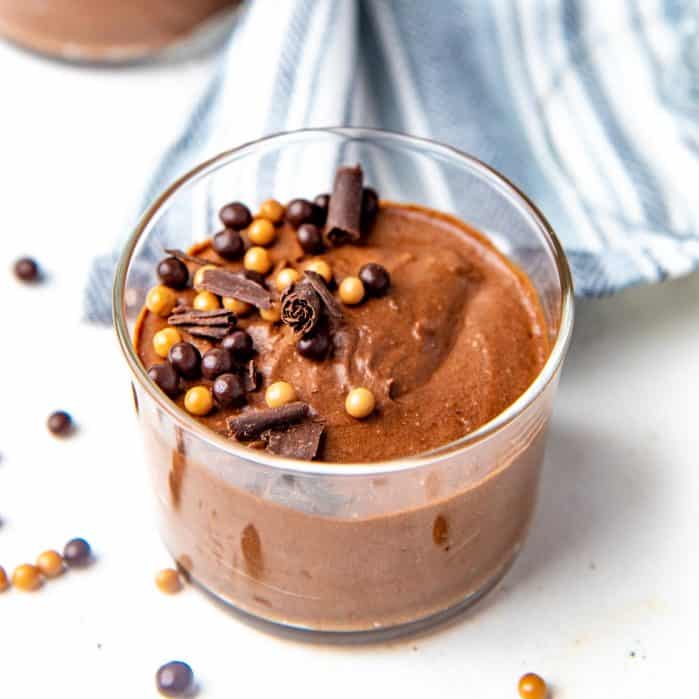Learn all the ways to make classic chocolate truffles with this step by step guide with troubleshooting tips. It’s the base recipe for other favorites such as these rum balls, chocolate peppermint truffles, chocolate champagne truffles etc. Here I’ll share my favorite easy chocolate truffles recipe, and all the tips and ways to shape and decorate them.
What are chocolate truffles?
Chocolate truffles are rolled balls or squares of ganache. These are one of the first no bake desserts I learned to make as a little kid, and ones I still make often for friends during the holidays, along with other goodies like peanut brittle, honeycomb candy, oatmeal lace cookies, chocolate caramels etc.
They are not to be confused with chocolate bonbons which are chocolate shells filled with fillings such as nut paste, fruit filling etc. The name truffle comes from the fact that a cocoa coated truffle resembles a mushroom truffle unearthed from the ground.
Why you’ll love this easy chocolate truffles recipe
Ingredients for chocolate truffles
You only need 2 main ingredients to make these simple chocolate truffles.
Chocolate (preferably a dark chocolate; semi-sweet chocolate or bitter-sweet chocolate) Heavy cream (or whipping cream – 35% fat)
However, for a richer, smoother, more delicious chocolate truffle, the ganache can also include butter, an inverted sugar syrup (such as corn syrup), and even other liquors or liqueurs. But for my basic chocolate truffles recipe here, we will only be using,
Chocolate – good quality couverture chocolate works best. I like Callebaut chocolate callets. Heavy cream – At least 35% fat content. You can use full fat coconut cream instead too. Butter – I prefer to use unsalted butter, but you can use salted butter too. Salt – optional, but really enhances the flavor. Skip / reduce if you’re using salted butter.
How to make chocolate truffles
These no bake chocolate truffles are so easy to make. Higher the liquid content, the more likely your truffles will need to be refrigerated to stay firm, because they will be too soft to handle at room temperature. With a higher amount of cream and/or butter, the truffles will be creamier in texture too. Lower the liquid content, the truffles are better at being firm at room temperature, and can be handled at room temp without softening or melting too much. However, you have to get the correct ratio. Otherwise, the chocolate will split, creating a grainy texture. So, for me, the ideal balance for chocolate truffles is 70 – 75% of liquid for every 100% of chocolate (milk chocolate, or semisweet or bittersweet chocolate).
Finely chop the chocolate.
First, if you’re using a high quality chocolate block, or large chocolate callets / wafers, you’ll need to chop the chocolate into finer pieces. Chopped chocolate dissolves easily. I use Callebaut chocolate callets that are like chocolate chips.
Heat the cream.
Place the cream in a saucepan and heat until just starting to simmer / boil. But do NOT let it come to a full boil.
Melt the chocolate.
Pour the hot cream over the chocolate and salt. Cover the bowl for about 1 minute to allow the chocolate to soften.
Mix to make the ganache / truffle base.
Whisk to emulsify the chocolate mixture until the chocolate is melted, shiny, and smooth. Also add the softened butter at this point so that it dissolves and mixes in the warm chocolate mix. This chocolate mix is the base for basic chocolate truffles.
Let the truffle base cool down and set.
You need to allow this truffle mixture to cool down and thicken, so that it can be shaped into truffles. Refrigerate the truffle base for at least 4 hours to let it set. Cover the surface of the ganache with plastic wrap or frequently stir it to prevent a skin from forming on top.
Shape and decorate the chocolate truffles.
This chocolate mix is the base for a classic chocolate truffle. You need to allow this truffle mixture to cool down and thicken, so that it can be shaped into truffles. The optimum temperature for ganache is between 82 – 92°F. When the chocolate goes beyond this temperature, the ganache is at risk of splitting. This is why I stress that the cream should not be heated until boiling. The emulsification can break if the ganache is too hot. Ideally, to make chocolate truffles, the chocolate is melted and tempered, and then cream and butter are heated to about 100 – 105°F and mixed to form a smooth, tempered ganache. Obviously, this is more time-consuming and technical, and not everyone knows how to temper chocolate. So, how do we make sure that the chocolate truffles we make are still incredibly smooth, silky, and have no grainy mouthfeel whatsoever? Because that’s precisely what my chocolate truffle recipe will produce!
Tips to make sure the chocolate ganache is silky smooth
Either cover the surface of the ganache with plastic wrap or frequently stir it to prevent a skin from forming on top.
How to shape chocolate ganache into truffles
There are THREE methods to shape chocolate truffles.
Rolled truffles
Rolled chocolate truffle balls are the most common, since they are easy and this is the classic truffle look. To keep this recipe easy and familiar, this is the method I use for these dark chocolate truffles.
How to make rolled truffles
Cover the surface of the ganache with plastic wrap to prevent a skin from forming on top. Allow the ganache to chill in the fridge for a few hours until firm. If you live in a colder climate or in the winter, you can leave these on your kitchen counter too. When the ganache is set, use a small cookie scoop to scoop out even portions of the ganache. You can also use a melon baller or regular teaspoon / spoon, but the cookie scoop allows each portion to be even in size. Take each portion and roll it into a ball and place it on a parchment paper-lined baking sheet. I like to roll the chocolate ganache into truffles while it’s still cold, so that it’s not too messy. Allow the rolled truffles to set once again (in the fridge or cool room temperature). Once set, they are ready to be coated.
Square truffles / cut truffles
This is the easiest way to make truffles. The chocolate ganache is cut into squares, rather than rolled into balls. I used this method to make these fantastic champagne truffles.
How to make square truffles
Make the ganache and let it slightly thicken. Once thickened (but pourable consistency), give the truffle mixture a little mix and then pour it into a 6 or 7 inch square baking pan that has been lined with parchment paper. Allow the chocolate ganache to set in the fridge. Once set, carefully remove the chocolate slab from the pan. Use a warm, sharp knife to cut the slab into equal-sized portions. Place each portion on a parchment paper-lined tray and let the sides of the truffles harden up again (they would be a little soft from the warm knife). Now you can dip or coat these truffles.
Piped truffles
Piped truffles are made in a professional setting. Rather than rolling or cutting them into portions, they are piped and formed into truffles. I used this method when I made my peppermint truffles.
How to make piped truffles
Allow the chocolate ganache to cool down until thick but pipeable. Place the ganache in a piping bag and pipe small mounds of ganache on a baking tray. Then let the ganache portions set on the surface.
How to coat chocolate truffles
There are two main ways to coat and serve your chocolate truffles.
Easy version
There are so many ingredients that you can use to coat your chocolate truffles with. The most classic is of course chocolate truffles with cocoa powder, because it makes the truffles look rustic, much like mushroom truffles that are covered in soil. For the easier version of chocolate truffles, roll them in unsweetened cocoa powder. The bitter sweetness and the classic simplicity are hard to beat. Other coating options include,
Ground / shaved chocolate, Desiccated coconut, Chopped nuts, Sprinkles (colored or chocolate sprinkles), Crushed cookies
Advanced version
The advanced version involves tempering chocolate and coating the truffles in the tempered chocolate. I recommend doing this only if you are familiar with working with chocolate. However, you can by pass tempering chocolate by using candy melts that do not require tempering. The first way to coat the truffles in tempered chocolate is to directly dip them in the chocolate using a dipping fork. The second way is to hand coat the truffles. To do this, take a little melted chocolate into your palm and roll the truffle in it to coat. For both methods, I like to chill the tray first so that the chocolate coating sets faster. Here’s a great article on how to temper chocolate.
Dipping method
Dip the truffles in the tempered chocolate, and place them on a parchment paper-lined baking tray. Dipping gives the chocolate truffles a thicker coating, that is also smoother.
Rolling method
To prevent run off (or a chocolate puddle), roll the truffle in your palm with some tempered chocolate. Then allow them to set, and repeat for a second coating. This will give the truffles a nice, thin, rustic-looking coating. With both methods, you can sprinkle stuff on top before the chocolate coating sets. These can be indicative of what the flavor of your chocolate truffle is going to be. To keep things simple here, these chocolate truffles will not be coated with tempered chocolate. But you can absolutely choose to dip or roll your truffles in tempered chocolate if you prefer.
Chocolate truffle troubleshooting
My chocolate ganache is greasy and grainy (and separating)
Melted chocolate requires tempering. Chocolate that is melted, and not tempered properly, will form white patches on top as the chocolate sets. This is because the fat layer separates from the chocolate without emulsifying. Even if you melt chocolate with heavy cream or butter, chocolate still needs to be emulsified to form a super silky texture. So, if the ganache mixture isn’t emulsified to mix the chocolate solids with the cocoa butter and fat in the cream and butter, it will result in a greasy ganache that separates into a grainy mixture. This happens when the chocolate ganache is mixed while it’s too hot, OR if you haven’t added enough cream or butter to stabilize the ganache mixture.
How to fix a grainy or split ganache
If the ganache is above 95°F and grainy, add chopped chocolate into the ganache (up to 1% in weight), and stir it in. This will make the ganache a little thicker, but not much. If the ganache is lower than 75°F (and is starting to set or is quite thick and grainy), add a little warm heavy cream or butter and stir it in until it dissolves. This should help fix the ganache. You can also add egg yolks (1 or 2, depending on the ganache), and whisk that in as well. Since yolks are great at emulsifying (think mayonnaise), it will help to emulsify the ganache as well. If the ganache is more liquid (and hot), but looks grainy, wait until the chocolate ganache mixture has cooled down a little (to about 82 – 92°F). Then use a stick blender to mix the ganache, because at this temperature the ganache should be easily emulsified. However, there’s a neat little trick to doing this! When the ganache is at around 80 – 85°F, use the stick blender to blend the ganache mixture. The ganache mixture should be in a bowl or container (glass or metal) at this point, which allows the stick blender to be immersed. So, don’t use shallow bowls. As you blend, find the point at which the stick blender creates suction (i.e. you will feel the stick blender getting pulled in and there’s more resistance), and hold it there. Within a few moments (could even take a few minutes sometimes depending on the ganache temperature) the ganache will change from a grainy, liquidy consistency to a beautifully silky smooth, thick, shiny ganache! This takes a little practice to get there, but it works like a charm, and has never failed me! See the two images below for reference.
Why this works
The ganache should be very gently mixed at first to prevent splitting. But once it has split, the ganache must be vigorously agitated for the fat and liquid molecules to mix and form an emulsion again. Very similar to making mayonnaise with the stick blender. Here’s an image showing you the chocolate ganache texture for making perfect truffles. Upper left – A perfectly emulsified chocolate ganache for chocolate truffles. The ganache is very smooth and shiny! Upper right – Chocolate ganache made the traditional way, with the ganache temperature at about 85 F after mixing. This is still smooth, but not as shiny. It’s not perfect, but acceptable! This is most likely the result you will get with most chocolate truffle recipes online. Lower left – The ganache temperature is at 95 F. The ganache is clearly split, but still a little thick. You can see the fat layer solidified on top and around the edges of the chocolate. This chocolate is not smooth. You will feel the grainy texture when eating this. Lower right – Ganache that was melted with a final temperature of over 100 F. The chocolate is very runny, and still soft even after letting it set at the same temperature as the other chocolates. The fat has separated and solidified on top, and the ganache is very grainy.
My chocolate ganache won’t thicken / set
Chocolate ganache requires a high fat content to properly set at room temperature. If it’s not setting properly then,
Too much heavy cream / liquid was added to the ganache. I prefer the liquid to be 75% of the weight of the chocolate for truffles (less if using white chocolate). So, adding more than that could cause the ganache to be too runny.
The liquid added didn’t have enough fat. If you add milk instead of heavy cream to make truffles, this will also make the ganache more runny at room temperature. I use a combination of heavy cream and butter, and the fat helps to make the ganache more stable and thicker at room temperature. If you’re adding a low fat liquid, then you may need to reduce the amount of liquid you add to the ganache.
The ganache is too sticky
If the ganache is too sticky, that means too much liquid was added to the ganache. If it’s sticky even after refrigerating, then you will definitely need to add more chocolate. The chocolate ganache for the truffles should still be a little tacky, but hold its shape well at room temperature once properly chilled. To fix an overly sticky or runny ganache, you will need to add more chocolate or butter. If it’s only a little sticky, then a coating of cocoa powder will help!
The truffles are too dry and toppings don’t stick
Dry truffles could mean that the chocolate to cream ratio was higher (i.e. more chocolate). But this can also result in truffles that feel grainy when eating them. If you did follow the recipe and the truffles are still dry, it just could be that the ganache mix is chilled super well. If you can shape the ganache into truffle shapes, then you can coat the truffles! If your truffle toppings are too big and rough, they will have a harder time sticking to the chocolate as well in this case. So, I recommend using toppings that are smaller in size, or chopping them into smaller pieces (such as chopped nuts).
The ganache is too hard to roll
If you have a firm ganache and it’s hard to roll, it could be that the ganache mix is too cold, or almost frozen. Let the truffle mix soften a little at room temperature to make it easier to roll. There’s also a chance that you did not add enough cream to the ganache mix, but if the chocolate truffle tastes good and has a smooth mouthfeel, it’s A-OK!
How to store chocolate truffles
The chocolate ganache will shrink and expand if it’s frozen and thawed out. So, I prefer to handle the truffles while they are chilled, but not frozen. The expanding / contracting could cause cracks if you coat the chocolate truffles in tempered chocolate. I recommend storing the truffles in an airtight container and in the fridge for up to 2 weeks. They can also be stored at room temperature for 4 – 5 days.
When to make and serve these decadent chocolate truffle balls
These simple chocolate truffles are such an easy bite-sized treat to make. They are perfect for,
Christmas and holiday season Valentine’s day Birthdays Anniversaries Celebrating special occasions Cocktail parties – perfect bite-sized desserts Or just because!
Flavor variations
Bourbon chocolate truffles – Replace 3 – 4 tbsp of the cream with bourbon, for an extra boozy bourbon truffle. You can make rum truffles the same way. Chocolate orange truffles – Add 1.5 tsp of orange extract instead of vanilla extract. And replace 2 tbsp of cream with cointreau. Peppermint truffles – Add 1.5 tsp of peppermint extract which will give these truffles a well balanced minty flavor. Raspberry truffles – Replace 1/4 cup of cream with smooth raspberry puree (without the seeds). Mocha truffles – Dissolve 2 tsp of instant coffee in the cream before adding it to the chocolate. And here’s a list of other truffle flavors and variations that I’ve shared on the blog.
Frequently asked questions

